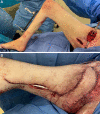SPINE: An Initiative to Reduce Pressure Sore Recurrence
- PMID: 36389613
- PMCID: PMC9653185
- DOI: 10.1097/GOX.0000000000004625
SPINE: An Initiative to Reduce Pressure Sore Recurrence
Abstract
The recurrence rate after pressure sore reconstruction remains high. Primary inciting factors can be organized into efforts aimed at wound prevention: spasticity relief, pressure off-loading, infection and contamination prevention, nutrition optimization, and maximizing extremity function. This article presents our detailed protocol, SPINE, to address each inciting factor with a summary of cases at our facility and review best practices from evidence-based medicine in the literature.
Copyright © 2022 The Authors. Published by Wolters Kluwer Health, Inc. on behalf of The American Society of Plastic Surgeons.
Figures






Similar articles
-
Evidence-based medicine: pressure sores.Plast Reconstr Surg. 2013 Dec;132(6):1720-1732. doi: 10.1097/PRS.0b013e3182a808ba. Plast Reconstr Surg. 2013. PMID: 24281597 Review.
-
Pressure ulcers: Prevention and management.J Am Acad Dermatol. 2019 Oct;81(4):893-902. doi: 10.1016/j.jaad.2018.12.068. Epub 2019 Jan 18. J Am Acad Dermatol. 2019. PMID: 30664906
-
Results of 268 pressure sores in 158 patients managed jointly by plastic surgery and rehabilitation medicine.Plast Reconstr Surg. 1998 Sep;102(3):765-72. doi: 10.1097/00006534-199809030-00022. Plast Reconstr Surg. 1998. PMID: 9727442
-
Management of recurrent ischial pressure sore with gracilis muscle flap and V-Y profunda femoris artery perforator-based flap.J Plast Reconstr Aesthet Surg. 2009 Oct;62(10):1339-46. doi: 10.1016/j.bjps.2007.12.092. Epub 2008 Jul 2. J Plast Reconstr Aesthet Surg. 2009. PMID: 18595789
-
Off-loading the diabetic foot for ulcer prevention and healing.J Vasc Surg. 2010 Sep;52(3 Suppl):37S-43S. doi: 10.1016/j.jvs.2010.06.007. J Vasc Surg. 2010. PMID: 20804932 Review.
Cited by
-
Various Flaps Used for Reconstruction of Pressure Injuries: A Narrative Review.World J Plast Surg. 2025;14(1):3-9. doi: 10.61186/wjps.14.1.3. World J Plast Surg. 2025. PMID: 40453398 Free PMC article. Review.
References
-
- Mervis JS, Phillips TJ. Pressure ulcers: prevention and management. J Am Acad Dermatol. 2019;81:893–902. - PubMed
-
- Guihan M, Garber SL, Bombardier CH, et al. . Lessons learned while conducting research on prevention of pressure ulcers in veterans with spinal cord injury. Arch Phys Med Rehabil. 2007;88:858–861. - PubMed
-
- Niazi ZB, Salzberg CA, Byrne DW, et al. . Recurrence of initial pressure ulcer in persons with spinal cord injuries. Adv Wound Care. 1997;10:38–42. - PubMed
LinkOut - more resources
Full Text Sources
